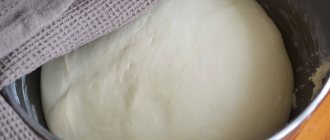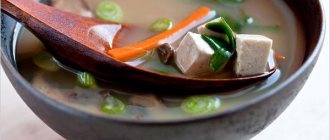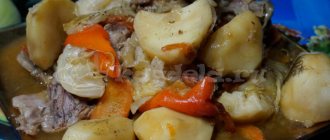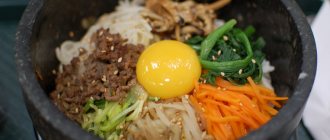Rich Ukrainian kulesh made from millet is an absolutely vegetarian recipe, despite the fact that in the Cossack tradition it was often fried with lard. But this is not at all necessary, because people were not always rich in this. Therefore, you can easily prepare an absolutely lean version of kulesh, but it will be finger-licking rich. After all, you can experiment and add not quite standard ingredients. In general, kulesh is a field dish that is ideally cooked over a fire, the so-called porridge, or half-soup, half-porridge. That is, it can be both the first and second course. And if you don’t like millet, then you can make buckwheat kulesh using the same principle.
How to cook
Place a saucepan with two liters of water over high heat and wait for the liquid to boil. At this time, it is necessary to rinse the cereal. Pour the millet into a deep plate and place it under the tap. Pour in half the volume of water and begin to drain it little by little from one edge so that the millet does not float away with the water. Pour water again, rinsing the millet. In two or three washes, the cereal is completely rid of excess and unnecessary impurities and dust.
It is important to remember that any recipe for making kulesh requires adding cereal only to boiling water. At the same time as the cereal, add a pinch of salt and a bay leaf. The cooking time for the cereal is about 20 minutes.
Before the end of the cooking time, add potato cubes to the pan. Now you can reduce the heat and simmer the dish until cooked.
While the potatoes are simmering, you can start preparing the frying. For the kulesh recipe you will need one onion and one small carrot. Vegetables are cut into small cubes. Place lard, cut into long pieces, into a frying pan. Fry it until a crispy dark brown crust appears. Now you can add vegetables to the lard. As soon as they turn golden, transfer the contents of the frying pan into a pan with millet and potatoes.
A couple more minutes and the fire can be turned off. When serving the dish, you can add one spoon of sour cream and fresh herbs.
Fish kulesh
Rich millet kulesh with crucian carp is an excellent dish for the dinner table that both children and adults will enjoy.
Cooking time – 1 hour.
Ingredients:
- 4 crucian carp;
- 4 potatoes;
- bulb;
- 4 tbsp. spoons of millet;
- carrot;
- greenery.
Cooking steps:
- Clean and gut the fish. Cut the peeled potatoes into cubes and cook.
- Cut the onion into small cubes, cut the carrots into circles.
- Fry carrots and onions in oil.
- When the potatoes boil, add the washed millet and cook for 10 minutes.
- Cut the fish into pieces and put it in the soup, add frying and spices. Cook for 20 minutes until the fish is done.
- Chop the greens into the finished kulesh.
This is a thick stew of millet, potatoes and lard, which, in fact, are the main and sufficient ingredients of this dish; All that remains is to add the onion. The Zaporozhye Cossacks (it is believed that it was they who invented kulesh) cooked it over an open fire in large cauldrons, which made it even tastier, with a smoky aroma. Therefore, if you have the opportunity, try cooking it over a fire, somewhere in nature or in the yard at your dacha.
- 150 g lard with meat streaks
- 100 g millet
- 6 medium potatoes
- 2 medium onions
- salt
- small bunch of parsley for serving, optional
- 2 liters of good drinking water
Kulesh with mushrooms and meat
Of course, the real thing is considered to be kulesh, consisting of a handful of millet, roots and spring water. However, modern chefs have learned to intelligently add other ingredients to this dish that do not spoil it, but only make it more satisfying and tastier.
We offer a second recipe for kulesh. Even a novice housewife can prepare it at home. The classic recipe is complemented by aromatic wild mushrooms and hearty pork. And herbs and spices can be added at your discretion and desire.
Kulesh recipe at home
Kulesh is deservedly considered a masterpiece of Ukrainian cuisine. In terms of popularity, it is second only to Ukrainian borscht. Kulesh appeared on the tables from the serving of the Zaporozhye Cossacks, who prepared it during campaigns and long trips, since this dish did not require any special conditions, no precise recipe, no special culinary skills. Later it became widespread throughout Ukraine and even gained fans in neighboring countries. Today, kulesh, or, as it is popularly called, “field soup,” is an indispensable attribute of picnics and gatherings around the fire.
How to cook kulesh?
The hallmark of Ukrainian cuisine is the ease of preparation and richness of the dishes. And kulesh in this regard is no exception. There are only 2 required ingredients: cereal and lard. Other products are optional. It can be meat, mushrooms, vegetables, herbs and much more. etc. You can take any cereal for kulesh; millet is most often used. Connoisseurs of culinary traditions cook it separately from other products and add it to an almost finished dish. For frying, lard is traditionally used, preferably with a meat cut. Although recently, recipes with beef, stew and even sausages have become equally popular. Season the finished dish with garlic and herbs. Kulesh can be easily prepared at home in the kitchen, but if you want to fully enjoy the taste and aroma of the dish, cook it over a fire!
Kulesh: recipe
Ingredients: Millet – 100 g Potatoes – 6 pcs. Pork lard (fresh) – 150 g Onion – 2 pcs. Spices - to taste
Pour approximately 2 liters of water into a saucepan and place on the stove to boil. Sort the grains and rinse under running water. As soon as the water for the kulesh boils, add the cereal, add ½ tsp. salt and cook for 15-20 minutes. When the millet is almost ready, add the chopped potatoes. Reduce heat and simmer until potatoes are done. Cut the lard into medium-sized cubes and fry a little to render out the fat. Then add chopped onion to the lard. Fry everything together until golden brown. When the potatoes become soft, add frying, salt, spices and stir. Delicious aromatic kulesh is ready!
Cossack kulesh: recipe over the fire
Ingredients: Millet – 200 g Carrots – 1 pc. Onion – 2 pcs. Potatoes – 4 pcs. Butter – 100 g Pork lard (fresh) – 200 g Spices – to taste Herbs (green onions, parsley and/or dill)
Cut fresh lard into cubes and place in a pot, let it fry slightly and release the fat. Chop the onion and grate the carrots. Place the vegetables in the pot and fry, stirring occasionally, for 5-7 minutes. Then pour 1.2-1.5 liters of water into the pot and leave to boil. Place chopped potatoes into boiling water. Cook for 5-7 minutes, then add thoroughly washed cereal. When the millet is cooked, add butter, spices and chopped herbs. Mix the kulesh thoroughly and serve.
Kulesh with meat: recipe
Ingredients: Millet – 300 g Meat (preferably beef) – 400 g Onion – 2 pcs. Pork lard (fresh) – 60-80 g Garlic – 2-3 cloves Bay leaf – 1-2 pcs. Spices (cloves, black and/or red pepper) - to taste Parsley
Cut the meat into cubes approximately 2 cm in size, cover with water. Place on the stove and cook, remembering to remove the noise from time to time. Then add a few peas of allspice, 1-2 small bay leaves, and cook until the meat is soft. Remove the finished meat from the broth and add the cereal, sorted and washed in several waters, into the pan. Cut fresh lard into cubes and melt in a frying pan over low heat. Fry the chopped onion in the resulting fat. 10-15 minutes before the millet is ready, put the meat, roasting and dry spices into the pan. Season the finished dish with parsley and crushed garlic.
Kulesh with stewed meat: recipe
Ingredients: Millet – 220 g Pork stew – 1 can (400 g) Potatoes – 10 pcs. Pork lard (fresh) – 150 g Onion – 2 pcs. Butter – 200 g Eggs – 7 pcs. Greens - 1 large bunch Spices - to taste
Cut the potatoes into cubes. 1 onion cut into 4 parts, chop the 2nd. Place potatoes and coarsely chopped onion in a saucepan (or kettle if cooking over a fire), pour 2 liters of cold water, add ½ tsp. salt and set to cook. When the potatoes are ready, remove the vegetables and mash them thoroughly with a fork. Pour the washed millet into the pan and cook until ready. When the cereal is cooked, add crushed potatoes with onions and stew. Stir and simmer over low heat. In a separate bowl, fry the diced lard and the remaining onion. When the onion is covered with a golden crust, place the roast in a pan with millet. Beat the eggs with a whisk and carefully add them to the porridge. Add chopped herbs, salt and spices. After 2-3 minutes the kulesh can be served.
Delicious kulesh in a slow cooker
Ingredients: Millet – 250 g Pearl barley – 250 g Pork (brisket) – 700 g Onion – 2 pcs. Carrots – 1 pc. Paprika – 3 tsp. Garlic – 6 cloves Spices – to taste
Rinse millet and pearl barley thoroughly under running water. Place in a bowl, add boiling water and simmer with the lid closed for 10-15 minutes. Then drain the water and rinse the cereal again. Cut the pork into medium-sized pieces, carrots into rings, and onions into cubes. Place everything in the multicooker bowl. Fry meat and vegetables in the “baking” mode. Do not close the lid to allow excess liquid to evaporate. When the meat becomes soft, add cereal, whole cloves of garlic and 5-6 tbsp. water. It is better to put the garlic directly in the peel, so it will retain its shape and will not dissolve during cooking. Close the multicooker lid, set the “pilaf” mode and cook until done.
Kulesh is an incredibly tasty, satisfying and easy-to-prepare dish that even a novice housewife can handle. Try preparing aromatic kulesh at home or on a picnic, and it will definitely become your family’s favorite dish.
Cooking method
The ancient recipe for kulesh required that cereals and roots be boiled in different containers. Today you can not adapt to traditions and significantly save time on cooking by boiling cereals and potatoes together.
Peel the potatoes and cut them into small cubes. We wash the millet several times in a plate filled with running water. Send the cereal and vegetables to cook over high heat for ten minutes. Don't forget to throw a couple of bay leaves, peppercorns and a pinch of salt into the pan. Then turn down the heat on the stove and simmer the kulesh for another fifteen minutes.
While the potatoes and millet are cooking on one burner, put a frying pan on another and fry the onions, meat and mushrooms on it. If store-bought frozen or fresh champignons were used for the dish, then no cooking is required. If you bought or personally picked aromatic wild mushrooms for cooking, then it is recommended to boil them for 40-60 minutes before frying.
Place the fried meat, onions and mushrooms in a pan where the millet has already been cooked and the potatoes have become soft and crumbly. All that remains is to turn off the heat, cover the container with a lid and let the dish brew for a while. The last stage is submission. We put thick kulesh into portioned plates, flavoring it with a couple of sprigs of fresh parsley and a spoonful of thick homemade sour cream.
Kulesh with pork stew
You can make kulesh with lard more satisfying by using stewed pork. To feel the full aroma and taste of kulesh, you can cook it over a fire. The ingredients are designed for a cauldron with a volume of 8-10 liters.
Cooking takes 1 hour.
Prepare the ingredients in advance if you are planning a hike or outdoor recreation. Take fresh lard. For a smoky flavor, extinguish a burning firebrand in the pot before removing from the fire.
Required ingredients:
- 4 large onions;
- 7 eggs;
- 2 carrots;
- lard – 400 g;
- 2 stacks millet;
- 1200 g potatoes;
- 2 cans of stew;
- greenery.
Ingredients:
- five potatoes;
- salt pepper;
- bay leaf – 2 leaves;
- greenery;
- 200 g mushrooms;
- one and a half liters of water;
- 2 medium onions;
- carrot;
- 6 tbsp. spoons of millet.
Preparation:
- Put the water on the fire, cut the carrots into strips, finely chop the onions.
- Peel the mushrooms and potatoes, cut into medium pieces.
- Fry the onion in a little oil, add the carrots. Fry for a few minutes.
- Add the mushrooms to the vegetables, stir and simmer until the liquid from the mushrooms has evaporated and the mushrooms are fried.
- When the mushrooms are ready, add the potatoes. Reduce heat to low.
- Simmer, stirring, potatoes for 5 minutes. Pour boiling water over the vegetables, bring to a boil and add salt.
- Add millet, cook, stirring until boiling, about 10 minutes.
- Add black pepper and bay leaf, chopped herbs.
- Cover the finished kulesh with a lid tightly and leave to simmer for 25 minutes.
Before serving, kulesh can be seasoned with fresh aromatic garlic.
How to properly cook kulesh at home with stew. Recipe for preparing a delicious “field” dish at home with photos.
Cooking time: 30-40 minutes.
Calorie content per 100 g - 260 kcal.
Kulesh is also sometimes called field or soldier's porridge. And also “food for warriors and travelers.” And it’s not hard to guess why - it’s quick and easy to prepare, most often outdoors in a pot. At the same time, it turns out very tasty and perfectly satiates.
Different regions prepare this dish in their own way. This is because the original porridge recipe has not been preserved or has undergone many changes. Many people associate the history of the dish with the great commander Alexander Suvorov.
There is a legend that during the Alpine crossing it suddenly turned out that the soldiers were left without provisions. Therefore, we decided to use all the remaining reserves. The result was a porridge made from pearl barley, buckwheat, millet and leftover meat. The dish turned out to be so tasty and satisfying that it quickly became widespread.
Although there is another version, according to which kulesh is classified as a thick first course of Ukrainian or Belarusian origin. Be that as it may, one thing can be said for sure: kulesh is a porridge or thick stew, the main component of which is millet. Additives such as potatoes, carrots, onions or meat (stewed meat, lard, chicken) are considered replaceable and can be added as desired.
Description of the cooking process
Perhaps you shouldn’t focus on the process of collecting firewood, laying out a fire pit, starting a fire and forming an improvised stove. Let's just say that the heat under the pot should be quite strong in the first stages of cooking.
So, since we do not have several burners on hand on which we could simultaneously cook and fry food, we slightly change the recipe for kulesh. We begin the cooking process not with cooking the cereal, but with frying the lard. Cut the lard into small cubes and place them on the bottom of the pot. As soon as the lard produces fat, add finely chopped onions and carrots to it. At this moment, do not move far from the fire, as the strong, almost uncontrollable fire under the pot fries everything very quickly. Stir the cracklings and vegetables constantly.
As soon as the frying is ready, pour water into the pot and pour in the millet. Mix thoroughly and cover with a lid. Cook the cereal for about fifteen minutes. During this time, you can peel and cut the potatoes into cubes. Make the fire under the pot a little smaller (by removing or simply pushing some of the burning coals to the side) and put the potatoes in the bowl. Simmer the dish over low heat for about 10-15 minutes, remove the pot from the fire, pour a large amount of fresh herbs into the container and, closing the lid again, let it rest and brew for a while.
Preparation:
- Rinse millet and pearl barley thoroughly under running water. Place in a bowl, add boiling water and simmer with the lid closed for 10-15 minutes. Then drain the water and rinse the cereal again.
- Cut the pork into medium-sized pieces, carrots into rings, and onions into cubes. Place everything in the multicooker bowl.
- Fry meat and vegetables in the “baking” mode. Do not close the lid to allow excess liquid to evaporate.
- When the meat becomes soft, add cereal, whole cloves of garlic and 5-6 tbsp. water. It is better to put the garlic directly in the peel, so it will retain its shape and will not dissolve during cooking.
- Close the multicooker lid, set the “pilaf” mode and cook until done.
Wash the crayfish, scald with boiling water and remove the heads. Rinse the millet several times with hot water. Peel the belly of the crayfish and stuff it with washed millet. Place the crayfish in a saucepan, add water, salt, add finely chopped onion and cook until tender. Serve hot.
Rinse the millet several times with hot water, put it in boiling broth and cook until fully cooked, then add finely chopped and lightly fried bacon with chopped onion and cook for another 3-5 minutes. Add salt to taste.
When serving, sprinkle the hot kulesh with finely chopped parsley. Kulesh can also be prepared with potatoes, replacing a third of the millet with 400 g of potatoes.
Wash dried mushrooms, add water and boil until tender. Drain the broth and finely chop the mushrooms. Put washed millet into the mushroom broth, cook for 15-20 minutes, then add diced potatoes and cook until tender. Mix finely chopped onions fried in vegetable oil with mushrooms and place in the kulesh. Stir and bring to a boil. When serving, sprinkle the kulesh with finely chopped parsley.
For the recipe you will need:
Cut the pork lard into small cubes and fry with chopped onions. Place washed millet in boiling water or broth, season with salt, and cook until almost done. Add lard and onions and cook for another 10-15 minutes.
For the recipe you will need:
Pour the sifted corn flour into boiling salted water and cook for about 15 minutes. Mix the finished kulesha well with a wooden spoon so that there are no lumps and place on a plate. Pour milk on top.
Wash the carrots and parsley, boil until tender, but do not drain the broth. Pour the sorted and washed peas with cold water so that it just covers the peas, let them swell, add a little butter, stale grated bread and cook. Place the cooked peas in a vegetable broth with carrots and parsley, rub through a sieve, season with sautéed onions, cut into strips and mixed with sautéed flour, add salt, mix well and bring to a boil.
Serve the kuleshik with white bread cut into cubes and toasted in the oven.
Pour one glass of sorted and washed pearl barley into three glasses of cold water, boil well and wipe. Separate the bones from the ruffs and cook the pulp until tender. Cook broth from fish heads, tails, bones and small fish with the addition of peeled and chopped carrots and parsley. Strain the finished broth, combine with boiled pearl barley and heat, stirring. When serving, place the ruff pulp into a plate with a kuleshik.
Peel the potatoes, rinse, cut into slices, combine with peeled and chopped sautéed leeks, add 4 cups of water, salt, cook for 15-20 minutes, then rub together with the broth through a sieve, add hot milk, stir and bring to a boil.
When serving, season the kuleshik with butter and egg yolks mixed with hot boiled milk.
Cut the peeled carrots into cubes, sauté in butter and cook in milk along with washed rice over low heat until tender. Rub the cooked carrots and rice together with the broth, pour in hot milk, add salt and sugar, let it boil and remove from heat. Mix the egg yolks with milk and this mixture, with thin pieces of butter, fill the kuleshik, stirring all the time
Wash the liver, cleared of film and bile ducts, cut into small cubes, fry in oil along with peeled and thinly sliced carrots, parsley and leeks and simmer for 30-40 minutes with the addition of water or broth. Pass the stewed liver through a meat grinder with a fine grid 2-3 times and rub through a sieve.
Sauté flour with butter, dilute with broth, cook for 15-20 minutes, strain, add grated liver, stir and bring to a boil.
Mix the egg yolks with milk and pieces of butter and season the kuleshik removed from the heat with them. Serve the kuleshik with dried cubes of white bread.
For the recipe you will need:
Peel the pumpkin, cut into small pieces, add 2 glasses of milk or water and cook. Saute the flour in butter, dilute with 4 cups of hot milk and 2 cups of water, let it boil, combine with the pumpkin and cook for 15-20 minutes. After this, rub the mixture through a sieve, add salt, add sugar, 1 glass of hot milk, bring to a boil, season with butter and stir. Serve the soup with diced buns (croutons) cut into cubes and dried in the oven.
Disassemble three quarters of the cauliflower taken for preparing kuleshika into inflorescences, rinse them and cook with 4 glasses of salted water along with peeled and sliced potatoes for 15-20 minutes. Wipe the cooked products, pour in hot milk and bring to a boil. When serving, season the kuleshik with butter and place small, previously selected cabbage stalks, boiled in salted water, on a plate.
Sort the grains, rinse and soak in cold water for 3 hours, cook until half cooked, then put in portioned pots, add onions and carrots cut into small cubes and sautéed in fat, prepared pieces of pork, diced raw potatoes, peeled and thinly sliced cucumbers, peppers, bay leaves; Pour all this over with salted broth and place in the oven for 1 hour.
Serve in a pot, sprinkle with herbs on top.
Hello, dear blog visitors! I have long wanted to write a post about how to cook kulesh
, but I kept coming across more “modern” recipes.
I think it 's kulesh, recipe
which I want to offer, if not completely forgotten, then does not receive due attention. At least among people I know closely.
But in vain! After all, what else can you feed your household quickly, satisfyingly, and most importantly,
delicious in just 10-15 minutes? Except that !
But that is another topic.
Before publishing the article, I decided to find out for myself – it corresponds
Is the dish we prepare as kulesh its true name.
I dug around the net and... what is it used for making it!
And yet, in one of the culinary reference books, the ingredients are precisely indicated,
used in our version.
So, let's get acquainted with the recipe
dishes called Belarusian version.
We will cook in a medium sized frying pan.
And, of course, salt. Cold water doesn't count.
Cut the meat into small cubes, approximately 10x10 mm. These are the cubes we have to
fry. Before this, do not forget to salt them to taste.
If the pork is fatty enough, then add oil to the pan.
just a little bit, literally lubricate the bottom. With lean meat
There must be more oil, otherwise it will burn.
Although we will fry the meat until it is semi-tender. But it's one thing when it's cool
fried, and another thing - burnt. In general, fry the squares until they
do not shrink to a minimum size, but at the same time, so that they can be
chew.
While the meat is roasting, let's prepare the so-called filling, simply
speaking, we need to dissolve flour in water.
Take a soup plate, pour flour into it, salt to taste and add a little at a time
cold water, while stirring the contents of the plate.
Add water until all the flour has dissolved and the mixture becomes
consistency of milk. Mix thoroughly so that there are no lumps left.
There should be more than half of the plate. If it’s more, then it’s okay -
and there will be more kulesh!
how to cook kulesh
If everything is ready, then we proceed to the final stage. It is assumed that meat
It was just getting ready. We take a plate with “milk” in our left hand
and pour a little into the frying pan.
With your right hand, vigorously mix the contents of the frying pan.
As for the left and right hands, for example, it’s as convenient for you as you like.
Actually, it’s such a simple thing, how to cook kulesh
better done at four
hands - cooking time is reduced by a third.
When the last drop from the plate falls into the frying pan, it can be considered kulesh.
We've already prepared it! For order, stir for another minute and remove the pan.
let's try. I think you'll like it.
Of course, the dish is far from dietary, but its recipe
good to hold
in stock: how many times has it come to the rescue in a situation when you need something quick but satisfying?
With this I say goodbye to you, all the best to you and see you again on the blog!
"Tasty" facts
- In some traditional families, vegetables and meat ingredients are cooked separately, and millet is cooked separately. At the last moment, the ingredients are combined and the fire is immediately turned off.
- The dish is a fairly thick and rich soup. A tasty and satisfying kulesh can replace the second and first courses.
- Traditionally, the recipe for millet kulesh must contain lard, but recently chefs have been replacing it with sausages, beef fat or chicken fillet.
- Chilled kulesh can be stored in the refrigerator for more than two days.
- If you want to prepare a lean dish, then instead of lard, mushrooms are placed in the kulesh, and frying is done without adding oil.










